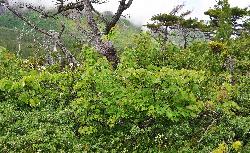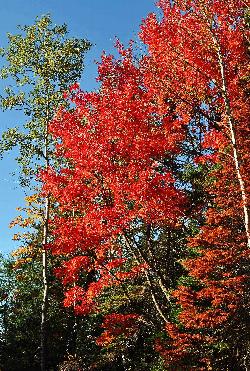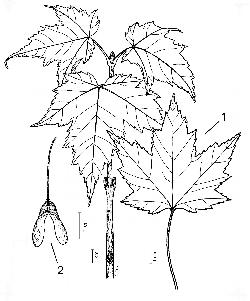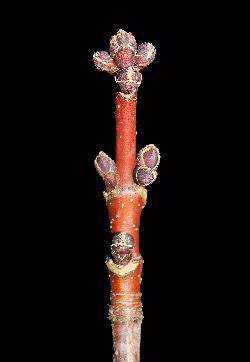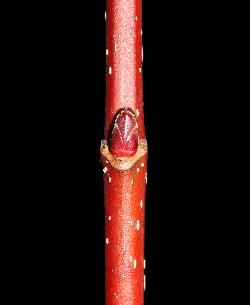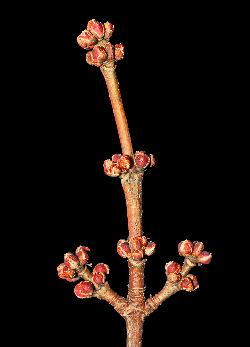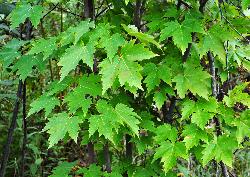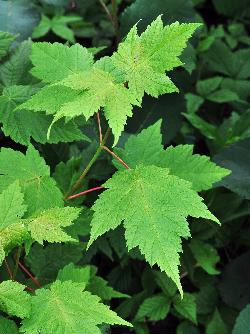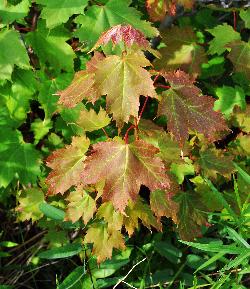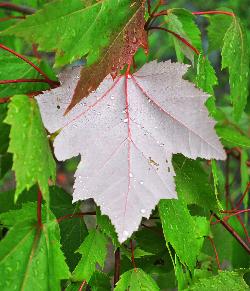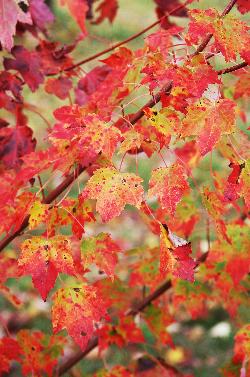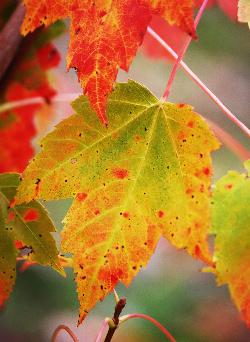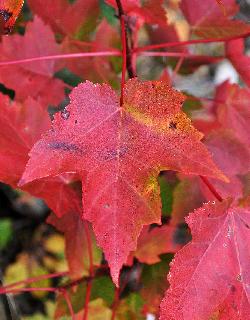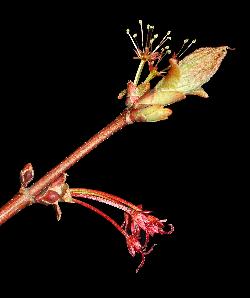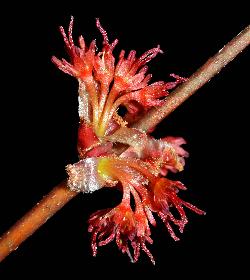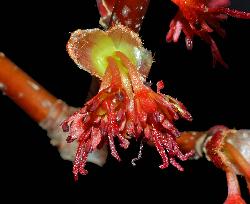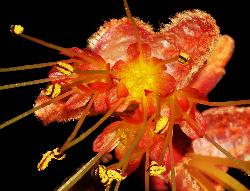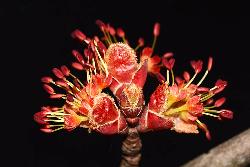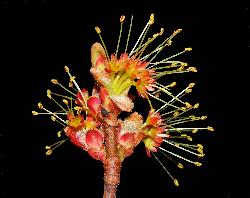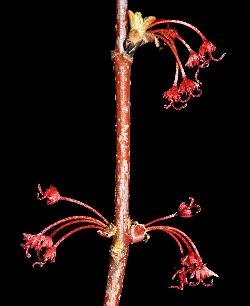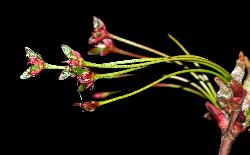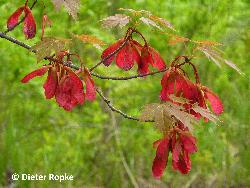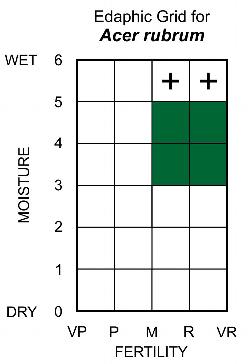Fr: érable rouge, plaine rouge, érable du Canada
Sapindaceae - Maple Family
Note: Numbers provided in square brackets in the text refer to the image presented above; image numbers are displayed to the lower left of each image.
General: A medium-sized deciduous tree [1–2], up to 25 m tall, with a d.b.h. of 60 cm, and living up to 100 years (Farrar 1995). Red maple is moderately shade-tolerant, usually shallow-rooted, and very tolerant of flooding (Walter and Yawney 1990). Red maple is also a pioneer species that can tolerate a wide range of soil and moisture regime conditions, from dry sandy soils to wet swamps, and sprouts quickly from the root crown or stump after cutting or fire. Due to its brilliant fall foliage [3], red maple is often planted as a shade tree, while its wood is used commercially for lumber, furniture, cabinetry, and a variety of wood products (Meier 1995); it also provides browse for wildlife, and is considered an important early spring nectar source for bees and other insects (Batra 1985).
Key Features: (numbers 1–2 refer to the illustration [4])
- Leaves have 3–5 lobes; the central lobe of the leaf blade is shouldered, with straight, nearly parallel sides at the base.
- The angle between the two wings of the samaras is V-shaped and narrow.
- Flowers are usually red and occur in short dense unisexual clusters near twig ends and bloom well before the leaves appear [5].
Stems/twigs: Twigs are red to reddish-brown, smooth (glabrous) and somewhat shiny, with small scattered pale lenticels. The terminal and opposite lateral buds are ovoid and blunt (obtuse), with 3–4 pairs of overlapping (imbricate) dark red bud scales that have a narrow ciliate margin of pale hairs [6–7, 22]. Terminal buds are 3–4 mm long, lateral buds are shorter. Flower buds are globose and clustered near the end of the twig on short shoots [8]. Leaf scars are narrow and broadly U- or V-shaped, with 3 vascular trace scars. The bark of mature trees is greyish-brown with deep furrows and narrow scaly ridges that are loose along the edges [9].
Leaves: Opposite, simple, palmately lobed and veined, and petiolate [10–11]. The petioles are 5–10 cm long and often red in colour. Leaf blades are 5–15 cm wide and have 3–5 lobes that are quite variable in size and length; the central and upper lateral lobes are shouldered, abruptly indented in a step-like fashion to a sharply pointed (acuminate) apex [12]. The base of the central lobe has nearly straight sides and the angle of the sinuses between the terminal and lateral lobes is usually less than 90°. Emerging leaves are often bronze or bright red in colour [13], while mature leaves are green and glabrous above and distinctly paler to glaucous or finely hairy beneath [14]. Leaf bases are nearly truncate to cordate and margins are sharply serrate. Leaves often turn red in autumn, although leaf blades may be mottled with green, yellow, orange, and/or red [15–17].
Flowers: Mainly unisexual; young trees may have unisexual flowers on different trees (plants dioecious), while mature trees will have unisexual flowers on the same tree or branch (plants monoecious) [18]; bisexual flowers may also be present [19–20]. Flowers are red and glabrous, with a deeply divided 5-lobed calyx and 5 petals; calyx lobes and petals are oblong and blunt, with the petals slightly smaller than the calyx lobes; a nectar disk is present at the base of the flower, where drops of nectar can be seen between the stamens [21] or at the base of the ovary. Male flowers occur in short dense clusters near the branch tips and have 3–12 (often 8) stamens [22–24]. Female flowers occur in umbel-like clusters from the lateral buds and have slender arching pedicels that lengthen in fruit [25–26]. The superior ovary has 2 winged carpels and 2 deep red styles, which are stigmatic along the inner surface. Flowers bloom in early spring, well before the leaves emerge; pollination is by insects (entomophily), including andrenid bees, honey bees, syrphid flies, and a variety of other flies, bees, wasps, and beetles (Batra 1985).
Fruit: Pairs of winged samaras (commonly called maple keys), each 1.5–2.5 cm long, are borne on elongate pendant pedicels [27]. Samaras have divergent or downward-pointing wings with a narrow V-shaped angle, (less than 90°) between the wings. Immature samaras are red, occasionally green, maturing to light brown and becoming veiny over the seed case. Samaras ripen in late spring; dispersal is by wind (anemochory).
Ecology and Habitat: Red maple is an uncommon tree in some areas of Newfoundland; it is most common in western and northeastern Newfoundland, and is absent from Labrador. Red maple trees usually occurs sporadically in forests on moist to wet, nutrient-rich soils, particularly on lower seepage slopes. It can increase in abundance as a shrub after fire or cutting, but only few survive in the mature conifer forest.
Edaphic Grid: See image [28]: the Edaphic Grid for Acer rubrum.
Forest Types: Red maple is most frequently encountered in low abundance in the following forest types:
- Abietum rubetosum (Rubus-Balsam Fir Forest Subassociation)
- Betuletum rubetosum (Rubus-White Birch Forest Subassociation)
- Populo-Betuletum papyriferae (Birch-Aspen Forest Association)
Poorly growing shrubby forms of red maple may be encountered in the Osmundo-Piceetum (Osmunda-Black Spruce Fen Association) and Kalmio-Piceetum (Kalmia-Conifer Forest Association).
Succession: Red maple only occurs as single mature trees within conifer-dominated stands on moist to wet nutrient-rich soils. It can increase in abundance in early seral stages after fire and cutting, but rarely survives to maturity.
Distribution: Within the province, red maple occurs most commonly in western, central, northeastern, and southern regions of the Island, but is absent from the Great Northern Peninsula, as well as Labrador. In North America, it also occurs in Nova Scotia and southern Québec to southern and southwestern Ontario, extreme southeastern Manitoba, and northern Minnesota; south to Wisconsin, Illinois, Missouri, eastern Oklahoma, eastern Texas, and east to Florida (Walters and Yawney 1990).
Similar Species: The only other native maple in Newfoundland and Labrador is mountain maple (Acer spicatum Lam.). Both have leaves with 3–5 lobes, although mountain maple is more likely to have just 3 prominent lobes, which are triangular and taper gradually to the apex, while red maple leaves have shouldered lobes, narrowing in an indented manner to the apex of each lobe. Mountain maple flowers are yellowish-green to white and arranged in elongate erect terminal panicles that bloom after the leaves have expanded, while red maple flowers are red and occur in short dense clusters near the ends of the twigs, blooming before the leaves expand.



